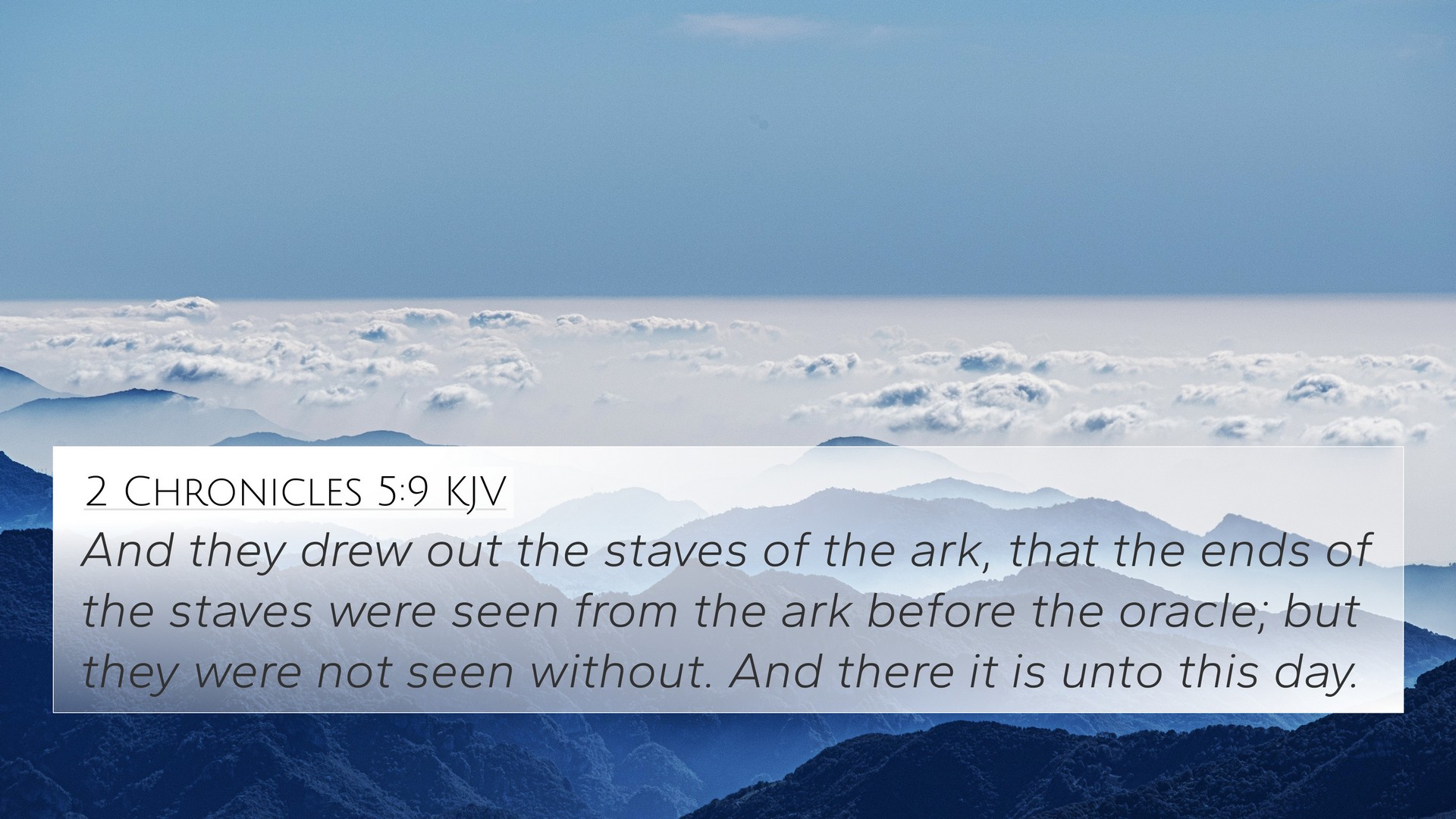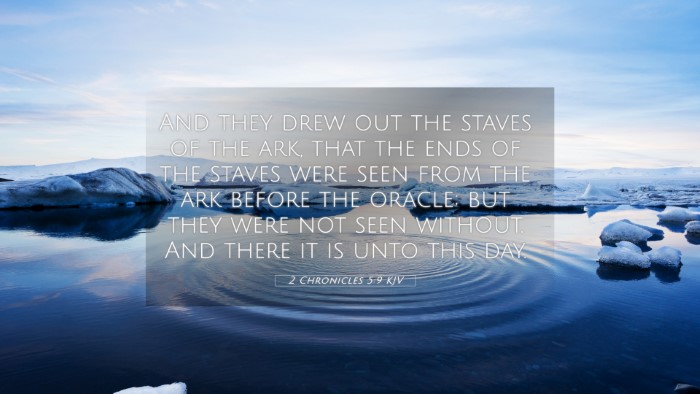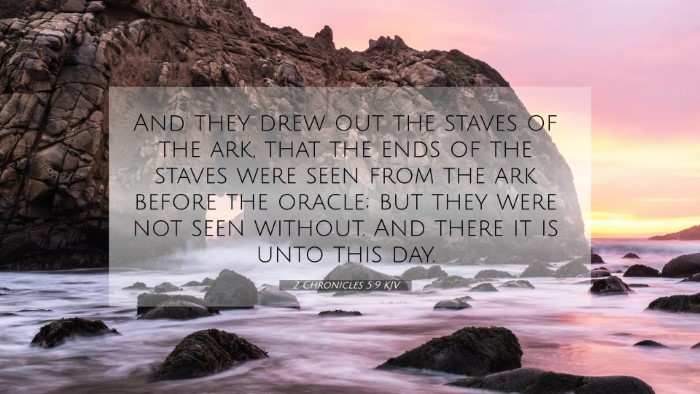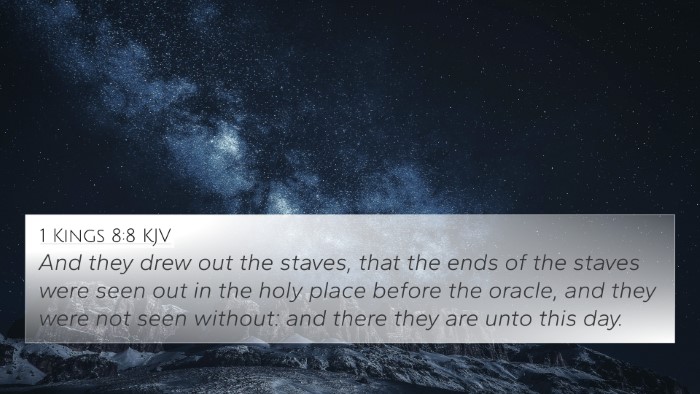Understanding 2 Chronicles 5:9
The verse 2 Chronicles 5:9 reads: "And they drew out the staves of the ark, that the ends of the staves were seen from the ark before the oracle; but they were not seen without the oracle." This passage is rich in meaning and symbolism related to God's presence and the significance of the Ark of the Covenant.
Verse Meaning and Interpretation
This verse highlights a pivotal moment during the dedication of Solomon's Temple, where the Ark of the Covenant was placed in the Most Holy Place. The following insights combine interpretations from public domain commentaries.
Significance of the Ark
-
God's Presence: The Ark of the Covenant represented the presence of God among His people. Matthew Henry notes that this was a profound way of demonstrating God's commitment to dwell with Israel.
-
Holiness of the Tent: Adam Clarke emphasizes the holiness associated with the Ark and the importance of proper procedures when handling sacred objects, which directly relates to the respect given to God's presence.
-
Divine Order: The narrative illustrates God's divine order and the necessity for His people to recognize and adhere to the holiness of the institutions He has set in place (Albert Barnes).
Symbolism of the Staves
The staves of the Ark are significant. They were designed to remain in the Ark, symbolizing God's eternal presence in the midst of His people, yet now they were visible, showing the direct connection to God from the Ark.
-
Visible Reminders: The visibility of the staves indicates that the direction of God's presence was always accessible, representative of His guidance (Barnes).
-
Transition from Wilderness to Temple: The able visibility can be seen as a transition from the mobile worship during the Exodus to a permanent dwelling in the Temple (Henry).
Chefs and Priestly Duties
This passage also speaks to the role of the priests as mediators between God and the people. They were responsible for the holy items and their placement.
-
Covenantal Relationship: Highlighted by Clarke, the responsibilities of the priests emphasized Israel’s covenantal relationship with God, demonstrating their role in upholding the law and order established by God.
-
Leading by Example: The priests were tasked with maintaining reverence during temple services, reflecting the serious nature of worship and reverent service to God (Henry).
Connections with Other Scriptures
This verse offers profound connections with other scriptural passages. The following cross-references illuminate the thematic links within the Bible:
- Exodus 25:10-22 — The original instructions for building the Ark of the Covenant.
- Numbers 4:15 — Instructions on handling the Ark which relates to the sacredness of the object.
- 1 Kings 8:6 — The moment the Ark was brought into Solomon's Temple.
- Hebrews 9:4 — A New Testament reference to the contents of the Ark and its significance.
- Deuteronomy 10:8 — Discusses the Levites' role and their relationship with the Ark.
- Psalms 132:8-10 — Expresses a prayerful invocation regarding the Ark and God's dwelling.
- Jeremiah 3:16 — A prophetic reference to the future time when the Ark will not be remembered.
Thematic Bible Verse Connections
By understanding 2 Chronicles 5:9 through these connections, we can observe themes of God’s presence, holiness, and divine order encapsulated throughout Scripture.
-
Divine Guidance: The role of the Ark as a guide to the Israelites showcases a significant theme of divine guidance in their journey (Proverbs 3:5-6).
-
Reverent Worship: Connections between 2 Chronicles 5 and spiritual reverence can be found in passages like John 4:24 which speak of worshipping in spirit and truth.
Conclusion
In summary, 2 Chronicles 5:9 serves as a powerful reminder of God's tangible presence among His people, the responsibilities of spiritual leaders, and the importance of reverence in worship. The Ark of the Covenant is not only central to the Israelite identity but also remains a vital symbol in understanding God's relationship with humanity throughout the Biblical narrative.



